The digital advertising space is crowded, complex, and full of opportunities to maximize your return on ad spent. One common question marketers ask is whether to invest in Facebook (Meta) Ads or Google Ads. This blog post aims to shed light on this debate. Wondering which platform will give you the results for your ad budget? Let’s dive into Facebook vs. Google ads.
When it comes to online advertising, you’ve got two big players: Facebook Ads and Google Ads. These platforms work differently and serve distinct purposes. Facebook Ads are all about social media. They let you show your ads on Facebook, Instagram, Messenger, and Audience Network. You can target people based on things like their age, interests, and what they do online.
On the other hand, Google Ads are more about search. They show up when someone searches for something on Google. You pick keywords related to your business, and your ads pop up when people search for those words. So, Facebook is great for reaching specific groups, while Google helps you when people are actively looking for what you offer. Both are useful tools, but your choice depends on where your audience hangs out and what you want to achieve.
Look at this table for a quick overview of each platform’s strengths and things to think about. The following table will help you understand them better as you go through the article.
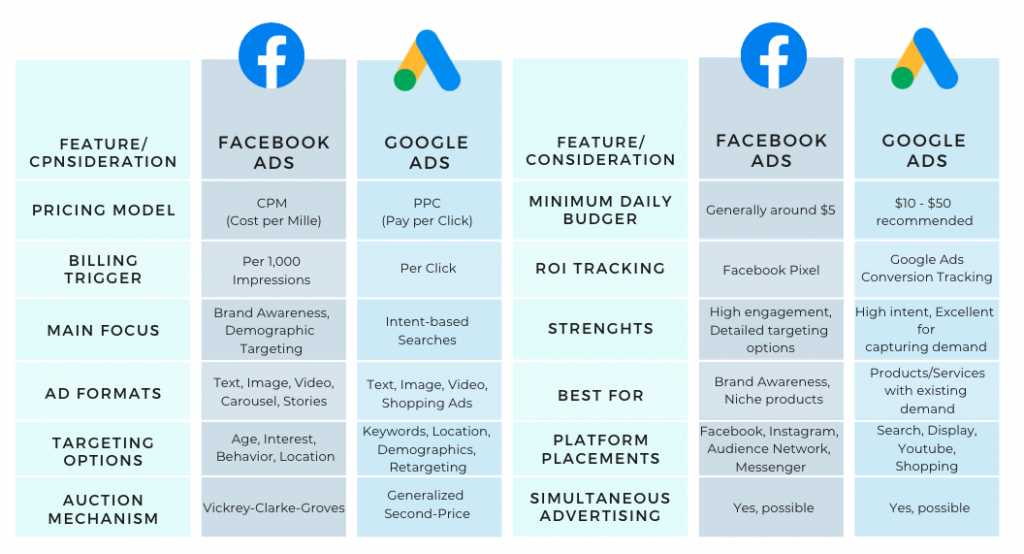
Facebook vs. Google Ads: Pricing Strategies
Now, let’s compare the pricing methods and strategies. So, in the next section of the blog post, we’ll dive deep into Facebook vs. Google ads pricing strategies.
On Facebook, the primary billing model is Cost Per Mille (CPM), where you are charged per 1,000 impressions. Here, the Click-Through Rate (CTR) becomes a key performance indicator. Higher CTR means more people are clicking your ad, making each impression more valuable.
Moving to Google ads. Google primarily operates on a Pay-per-click (PPC) model. You’re billed only when someone clicks on your ad. Therefore, it makes sense to provide as much information as possible within the ad to attract qualified clicks.
Example of well constructed Facebook ad
Imagine you’re selling artisanal coffee. Your Facebook ad might focus on the unique story behind your coffee beans, using emotionally resonant visuals of coffee fields, smiling farmers, and a cup of freshly brewed coffee.
Example of well constructed Google ad
For the same artisanal coffee, your Google Ad could say, “100% Organic Artisanal Coffee – Free Shipping on Orders Over $50.” Here, mentioning the price point or free shipping can help qualify the lead before they click, saving you money on unqualified clicks.
Discover Trends before they’re Trending.
Get our best trends delivered to your inbox.
For Facebook, focuse on maximizing CTR by creating compelling, emotionally engaging ads. Mentioning pricing or free shipping is usually not as effective here as it is on Google, where such information can actually help to pre-qualify your clicks and save you money.
In both platforms, truthful bidding is the game theory optimal strategy. The auction mechanisms—Vickrey-Clarke-Groves for Facebook and Generalized Second-Price for Google—are designed to encourage advertisers to bid their true valuations. But, more about this in the next part.
Understanding How Ads are Displayed in Auctions
When it comes to advertising on Facebook and Google, understanding how ads are priced can be a game-changer for your budget and strategy. Let’s break it down in simple terms.
So, let’s start with Facebook. Facebook uses something called the Vickrey-Clarke-Groves mechanism. It might sound complex, but it’s not. Essentially, it means you’re charged based on the “hurt” you cause to other advertisers by winning the bid, not just your bid amount. So, if your ad wins and causes others to miss out, you’ll pay a price that reflects that impact.
On the other hand, Google Ads uses a Generalized Second-Price auction. Here, you pay just a cent more than the second-highest bid. This system encourages advertisers to bid honestly because trying to lowball doesn’t give you any strategic advantage.
Discover Trends before they’re Trending.
Get our best trends delivered to your inbox.
Now, let’s talk about what this means for you. Understanding these mechanisms is crucial for budgeting and creating bid strategies that work for each platform. In both cases, your aim should be to calculate your allowed customer acquisition cost.
With the right (truthful) bid, you can get the most out of your ad budget and maximize your ad’s performance. So, keep these auction systems in mind as you plan your advertising campaigns on Facebook and Google.
Facebook vs. Google Ads: Cost Benchmarks
It’s time to see Facebook vs. Google ads regarding the cost. When it comes to advertising online, knowing how much you might spend is important. ž
Let’s talk numbers for a moment. On Facebook, the average cost for all ads is about $7.76. Google Ads, on the other hand, tend to be cheaper, with an average of $0.62 for all ads.

But it’s not just about averages; different types of ads have different costs. For example, Facebook’s prospecting ads average around $7.29, while retargeting ads can be a bit more expensive at $9.24.
On Google, the cost varies too: Performance Max. ads are around $0.60, search ads are about $0.70, and shopping ads tend to be the most affordable at $0.48. These numbers give you a sense of what to expect, helping you plan your advertising budget wisely.
Placement Comparison
Regarding placements, both Google and Facebook (Meta) offer various spots to showcase your ads. On Google, you can put your ads in different places like the Search Network, Display Network, Google Shopping, YouTube, Google Maps, and even Gmail.
Meanwhile, on Facebook (Meta), your ads can find a home in the Facebook Feed, the Right Column, Stories on Facebook, and even Stories on Instagram.
Also, they can appear in the Audience Network, Facebook Messenger, WhatsApp, In-Stream Videos, and the Facebook Marketplace. So, you’ve got plenty of options to reach your audience on both platforms!

Here are some platform-specific insights. YouTube is probably the best channel for brand awareness.
However, for small and medium-sized e-commerce businesses, Instagram and Facebook generally provide a better average Customer Acquisition Cost (CAC), according to our benchmark article.
How to Maximize ROI on Each Platform
To boost your ROI on Facebook and Google, here’s a handy approach: On Facebook, make sure your ads have eye-catching visuals and messages that really connect with people emotionally. On Google, use clear text and extra information to make sure you’re attracting clicks from folks who are genuinely interested.
Now, let’s talk about finding and fixing mistakes that might be hurting your ROI. You can uncover setup mistakes by carefully auditing your ads. This process involves reviewing your ad campaigns to ensure everything is set up correctly for optimal performance. Additionally, it’s important to compare your results with industry benchmarks. If you notice significant discrepancies, it’s a sign that adjustments may be needed to improve your ROI.
And guess what? Lebesgue can make all of this super easy. It’s a tool that does these audits and benchmarks automatically. So, you can see your numbers and where you need to improve without any hassle.
If you want to get the most out of your advertising on Facebook and Google, Lebesgue is there to help you out.
Summing Up
So, Facebook vs. Google ads? Both platforms offer unique advantages and limitations. Your choice will depend on your specific advertising goals, target audience, and the type of content you produce. If brand awareness is your aim, Facebook’s vast reach could be beneficial. If you’re looking for high-intent traffic, Google might be your best bet.
⭐⭐⭐⭐⭐
100+ five-star reviews on Shopify App Store
FAQs
Here are some most frequently asked questions and answers.
Q: What are the minimum budgets for advertising on Facebook and Google?
When it comes to ad budgets, both Facebook and Google offer some flexibility. Facebook doesn’t impose a strict minimum budget, but it’s generally recommended to begin with at least $5 a day for your ad sets. This allocation allows you to accumulate enough data to fine-tune and optimize your campaigns effectively. Similarly, Google Ads doesn’t have a rigid minimum budget requirement. Starting small, typically in the range of $10 to $50 per day, depending on the competition and industry, can be a sound approach. Google’s daily budget settings offer room for adjustment based on your campaign’s performance and objectives, giving you the flexibility to manage your spending effectively.
Q: How do I track ROI effectively?
For effective tracking of your advertising efforts on both Facebook and Google, there are valuable tools at your disposal. On Facebook, you can make the most of the Facebook Pixel, which allows you to monitor website actions resulting from your Facebook ads. This tool provides insights into critical performance indicators like conversion rates and the value per lead. The beauty of it is that you can access this data directly within Facebook Ads Manager.
Similarly, Google offers robust conversion tracking features. These features offer insights into what occurs after a user clicks on your ads. By setting up Google Ads conversion tracking, you can keep a close eye on crucial actions such as completed purchases, form submissions, and even phone calls generated by your ads.
To get a more comprehensive view of your advertising ROI, both platforms allow you to use UTM parameters. These parameters enable you to track specific campaigns, ad sets, or even individual ads back to your website analytics, such as Google Analytics. This integration provides a more holistic understanding of your advertising performance across various platforms.
Discover Trends before they’re Trending.
Get our best trends delivered to your inbox.
Q: Can I run my ads on both Facebook and Google at the same time?
Yes, you can advertise on both platforms simultaneously, and many advertisers do. Running campaigns on both platforms allows you to leverage their unique strengths:
- Facebook is excellent for brand awareness and targeting specific demographics.
- Google excels in capturing demand and is ideal for intent-based searches.
By advertising on both platforms, you can build brand awareness on Facebook while capturing that heightened intent through Google. However, it’s essential to monitor your campaigns closely to ensure you’re allocating your budget most effectively across both platforms.
Q: What’s the best way to know if my ads are working?
Facebook has its own built-in analytics through Facebook Pixel, and Google offers conversion tracking. You can use these tools to monitor key performance indicators like conversion rates, cost per click, and return on ad spend.
Q: Which platform is better for selling niche products? Facebook or Google?
Facebook’s robust targeting options make it easier to reach a very specific audience, making it a strong platform for advertising niche products.
Q: Are there any tips for saving money on Facebook or Google ads?
Both platforms operate on an auction system where bidding plays a significant role. It’s beneficial to start with a lower budget and gradually increase it based on the performance data you gather. Always remember to bid truthfully, as this is the game theory optimal strategy for both Facebook’s and Google’s auction systems.
⭐⭐⭐⭐⭐
100+ five-star reviews on Shopify App Store
Be the first to receive the latest Facebook and Google ads benchmarks, insights, and tips right in your inbox.
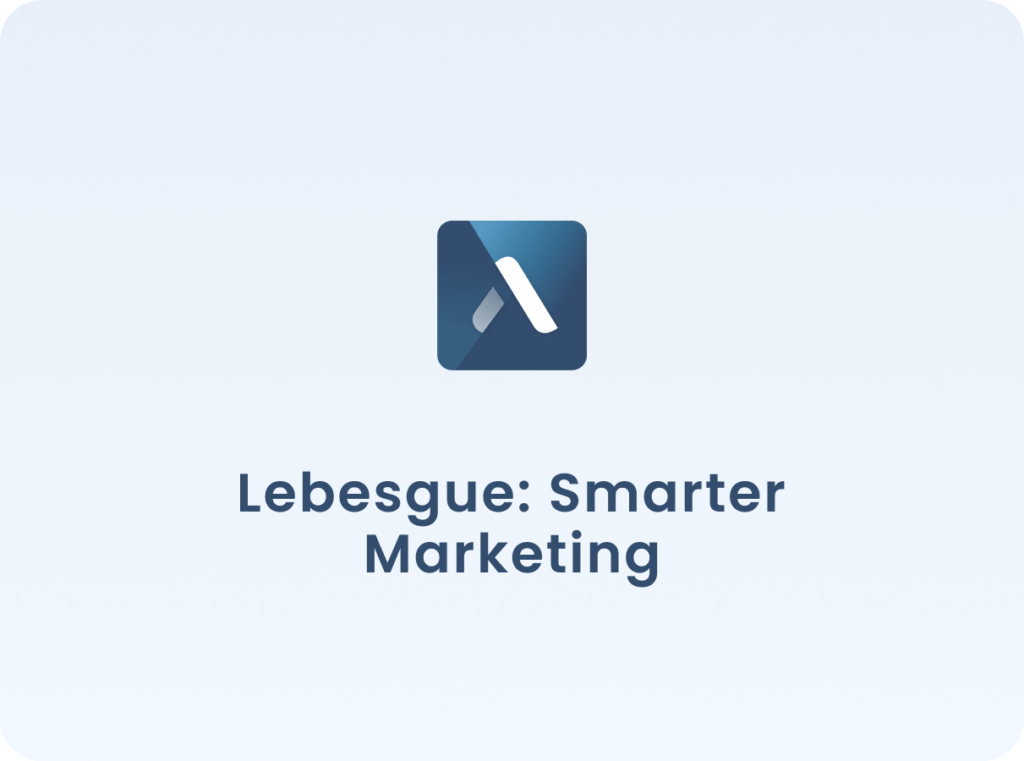
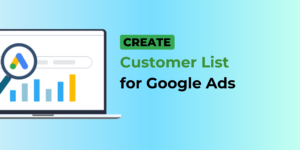
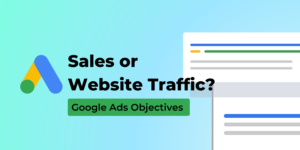
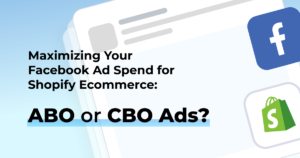
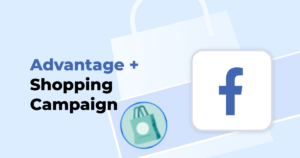
No comment yet, add your voice below!